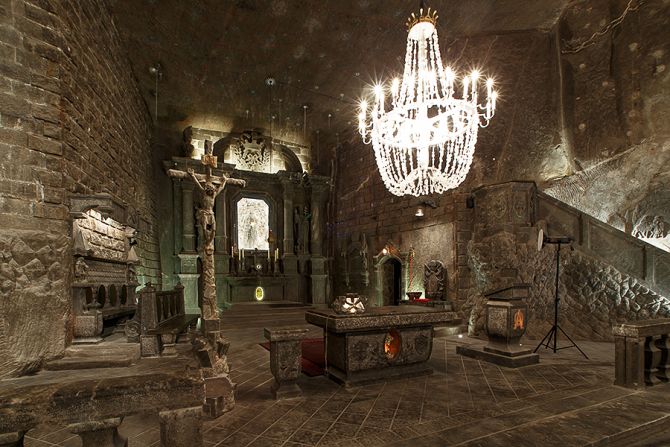Krakow, Poland, Jul 27, 2016 / 02:49 am
Located just southeast of Krakow, the Wieliczka salt mine is famous for many things – most notably its underground chapels, made entirely out of rock salt.
In fact, the chapels are so stunning that they have earned the mine a nickname: the 'underground salt cathedral.'
Officially opened in the 13th century, the mine is one of the oldest salt mines still in operation and is composed of numerous chambers chiseled out of rock salt, saline lakes, statues and chapels sculpted in salt.
Until now, the main visitor's route through the mine, called the "Tourist Route," has been walked by roughly 40 million tourists from around the world, according to the mine's official website.
In a show of just how deeply the faith is rooted in the Polish people, the mine is also filled with several chapels carved completely out of rock salt, in order to provide miners with a way to practice their faith while underground.
Since miners typically worked under dangerous circumstances in the dark, away from their families, they created the chapels as places where they could pray and celebrate Mass before facing the challenges of the job.
The shrines were chiseled near the miners' workplaces and at the major and minor shafts where tragic accidents had occurred.
While it isn't possible to determine exactly how many chapels and shrines once existed in the Wieliczka mine, the most important are shown on the "Pilgrims' Route," which, unlike the regular tourist route, allows groups accompanied by a priest to register and celebrate Mass inside one of the chapels.
The most important chapel, which is the largest and contains the most statutes and carvings, is the St. Kinga Chapel, which is located about 330 feet underground.
The large space inside the chapel measures roughly 5,000 square feet of floor space. It is 36 feet tall, and is decorated with bas-relief carvings in rock salt depicting important scenes in Jesus' life, such as the Nativity, the Last Supper and the Crucifixion.
It also contains carvings of important biblical events like the Slaughter of the Holy Innocents, and of saints. Two giant chandeliers made completely out of salt crystals hang from the ceiling, while an image of St. Kinga, also made entirely of salt crystals, sits behind the main altar.
The sculptures inside the chapel were carved over the course of 70 years, in large part thanks to a man named Erazma Baracza, an art lover and director of the mine.
Inside the main altar are two relics: one of St. Kinga, and one of St. John Paul II, who visited the mine three times during his life. Though he never went as Pope, the young Karol Wojtyla traveled to Wieliczka twice as a teen, and once as a cardinal.
Mass is still celebrated in the chapel every Sunday, as well as on special feast days or holidays. It is also used for special events such as weddings and sacred music concerts, seating about 400 people.
St. Kinga, the chapel's namesake, lived during the 13th century and was the daughter of Hungarian King Bela IV.
Although she had desired to live a life of celibacy, a young Polish prince named Boleslaw asked for her hand in marriage, and the pious Kinga reluctantly accepted.
(Story continues below)
When her father asked what she wanted to bring to her husband as a wedding gift, Kinga said she didn't want any gold or jewels, but preferred to bring something that could serve the people.
With this in mind, she asked her father for salt, since Poland had none. Her father easily agreed, and gave her his most prosperous salt mine.
Kinga and her husband Boleslaw, a devout couple, made a vow of celibacy despite their marriage, and carried out their reign in service to their people. The princess was known to have dedicated much of her time to visiting the poor and caring for lepers.
When Boleslaw died in 1279, the princess sold all of her material possessions and gave the money to the poor before entering the Poor Clares monastery at Sandec, preferring to dedicate her life to prayer rather than continuing with her responsibilities in governing the kingdom.
She spent the rest of her life in prayer, refusing for anyone to refer to her with her royal title "Grand Duchess of Poland." She died in 1292, and was beatified by Pope Alexander VIII in 1690. In 1695, she was named chief patroness of Poland and Lithuania.
Kinga was canonized by St. Pope John Paul II on June 16, 1999. In gratitude for her canonization, a statue of John Paul II was added to the St. Kinga chapel in the mine alongside a salt crystal sculpture of Our Lady of Lourdes.
The mine also contains chapels dedicated to the Holy Cross, to St. John, to St. Anthony and to St. John Paul II.
In 1076 the Wieliczka Salt Mine was entered into the National Register of Historic Monuments, and in 1978 was included on UNESCO's First World List of Natural and Cultural Heritages.



